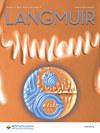利用振动和频谱学探究改性金纳米粒子的疏水性在调节脂质表面行为中的影响
IF 3.7
2区 化学
Q2 CHEMISTRY, MULTIDISCIPLINARY
引用次数: 0
摘要
深入了解纳米粒子的表面修饰如何影响其与细胞膜的相互作用,对于推进安全有效的生物医学应用至关重要。在影响这些相互作用的关键因素中,纳米粒子的疏水性起着至关重要的作用,主要由与细胞膜的疏水相互作用驱动。在此,我们利用振动和频谱生成技术研究了硫醇封端的金纳米粒子(GNPs)疏水烷基链长度对脂质表面的影响。我们利用 1,2-二棕榈酰-sn-甘油-3-磷酸胆碱(DPPC)单层脂质作为水面细胞膜的代表模型。我们的研究结果表明,用烷基链较短的硫醇配体(如庚硫醇(HT,C7))封端的 GNP 与脂质单层相互作用时,C-H 伸缩振动的变化极小。这些现象可能是由于硫醇封端的 GNP 的烷基链与脂膜的疏水基团之间的疏水-疏水相互作用引起的脂链扰动,或者仅仅是由于 GNP 在界面上的吸附而没有破坏单层结构。然而,随着硫醇封端的 GNPs 链长从癸硫醇(DDT,C10)增加到十八硫醇(ODT,C18),C-H 伸缩振动的光谱变化程度也随之增加。用氚代脂类进行的对照实验表明,加入 HT(C7)GNPs 后,C-H 伸缩振动的变化仅仅是因为它们在表面的存在,而没有改变单层结构。然而,在 DT(C10)和 DDT(C12)GNPs 中,单层与硫醇封端的 GNPs 烷基链之间的强疏水相互作用导致单层的取向次序增加。此外,在 ODT(C18)GNPs 的情况中,很长的烷基链导致单层结构发生明显的扰动,单层出现净无序化。在界面水分子的 O-H 振动中观察到的光谱变化进一步证实了这些观察结果。我们的研究结果揭示了 GNPs 的疏水性在影响界面方面的关键作用。了解这些影响对于药物递送应用以及提高脂基系统的稳定性和有效性至关重要。本文章由计算机程序翻译,如有差异,请以英文原文为准。

Probing the Influence of Hydrophobicity of Modified Gold Nanoparticles in Modulating the Lipid Surface Behavior Using Vibrational Sum Frequency Generation Spectroscopy
A deep understanding of how the surface modifications of nanoparticles impact their interactions with cell membranes is vital for advancing safe and effective biomedical applications. Among the pivotal factors governing these interactions, the hydrophobicity of nanoparticles plays a crucial role, predominantly driven by the hydrophobic interactions with the cell membrane. Herein, we study the influence of the hydrophobic alkyl chain length of thiol-capped gold nanoparticles (GNPs) on lipid surfaces with the help of vibrational sum frequency generation spectroscopy. We have utilized the zwitterionic 1,2-dipalmitoyl-sn-glycero-3-phosphocholine (DPPC) lipid monolayer as a representative model of cell membranes on the water surface. Our findings revealed that GNPs capped with the thiol ligand having a shorter alkyl chain such as heptanethiol (HT, C7) show minimal changes in the C–H stretching vibrations while interacting with the lipid monolayer. These observations could be attributed to the perturbation of the lipid chain due to hydrophobic–hydrophobic interactions between the alkyl chain of thiol-capped GNPs and the hydrophobic group of the lipid membrane or simply by the adsorption of GNPs at the interface without disrupting the monolayer structure. However, with increasing the chain length of thiol-capped GNPs from decanethiol (DDT, C10) to octadecanethiol (ODT, C18), the extent of spectral change in the C–H stretching vibration is increased. The controlled experiment performed with the deuterated lipids conforms that the changes observed in the C–H stretching vibration after adding HT (C7) GNPs are only because of their presence in the surface without altering the monolayer structure. However, in the case of DT (C10) and DDT (C12) GNPs, the strong hydrophobic interactions between the monolayer and the alkyl chain of the thiol-capped GNPs result in the increased orientational order of the monolayer. Moreover, in the case of ODT (C18) GNPs, the very long alkyl chain induces pronounced perturbations in the monolayer structure with net disordering of the monolayer. These observations are further supported by the spectral changes observed in the O–H vibration of the interfacial water molecules. Our findings reveal the crucial role of the hydrophobic nature of GNPs in influencing the interface. Understanding these effects is crucial for drug delivery applications and improving the stability and effectiveness of lipid-based systems.
求助全文
通过发布文献求助,成功后即可免费获取论文全文。
去求助
来源期刊

Langmuir
化学-材料科学:综合
CiteScore
6.50
自引率
10.30%
发文量
1464
审稿时长
2.1 months
期刊介绍:
Langmuir is an interdisciplinary journal publishing articles in the following subject categories:
Colloids: surfactants and self-assembly, dispersions, emulsions, foams
Interfaces: adsorption, reactions, films, forces
Biological Interfaces: biocolloids, biomolecular and biomimetic materials
Materials: nano- and mesostructured materials, polymers, gels, liquid crystals
Electrochemistry: interfacial charge transfer, charge transport, electrocatalysis, electrokinetic phenomena, bioelectrochemistry
Devices and Applications: sensors, fluidics, patterning, catalysis, photonic crystals
However, when high-impact, original work is submitted that does not fit within the above categories, decisions to accept or decline such papers will be based on one criteria: What Would Irving Do?
Langmuir ranks #2 in citations out of 136 journals in the category of Physical Chemistry with 113,157 total citations. The journal received an Impact Factor of 4.384*.
This journal is also indexed in the categories of Materials Science (ranked #1) and Multidisciplinary Chemistry (ranked #5).
 求助内容:
求助内容: 应助结果提醒方式:
应助结果提醒方式:


